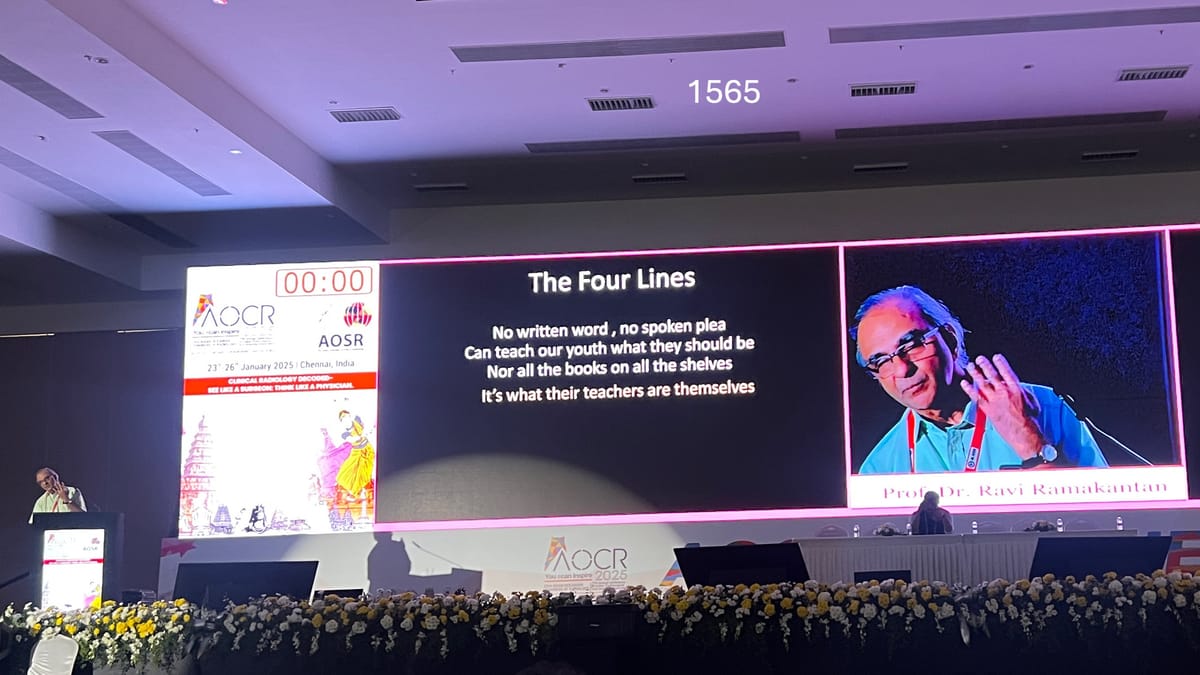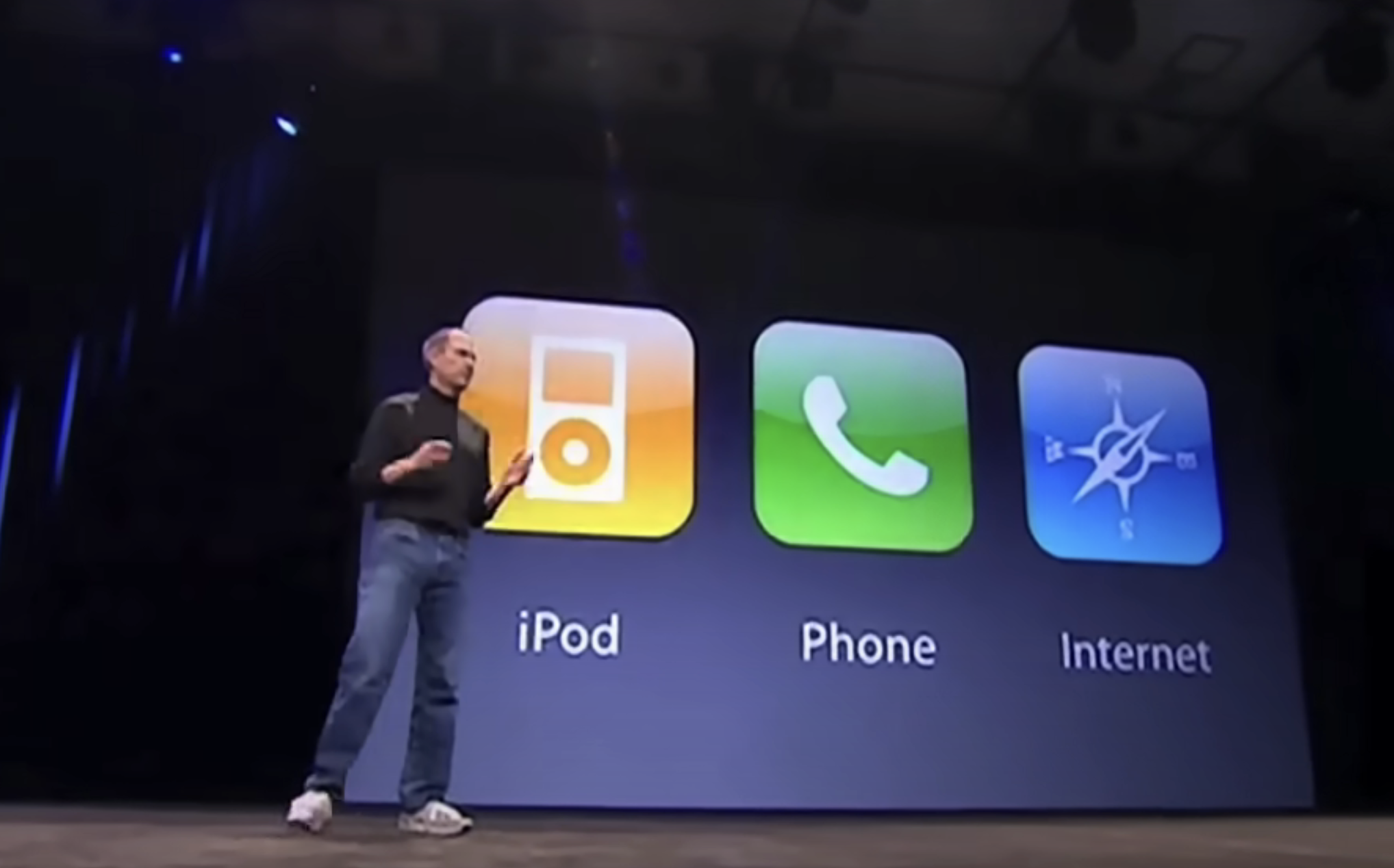
Counting Down to 90 - Week 1563 - What Ails Radiology and Medical Speakers and How to Fix it
If you’re delivering lectures to people who've to paid to attend to learn, you have a moral obligation to take the effort to deliver a talk that teaches, sends a message, doesn’t put the audience to sleep and ends before time.
The Concept Explained

Audio
Link to click if you don't see the audio below.
Text
Two weeks ago, I was at the AOCR, a radiology conference that featured a large number of international and national speakers.

Given that younger radiologists are smarter with superior communication skills, you would expect a marked increase in the quality of the lectures as compared to meetings in the past.
Unfortunately, nothing has changed in the last 30 years. Not at the AOCR and not at any other radiology or medical conference, including the one I attended just yesterday.
In any meeting, typically 20% percent of the speakers are fantastic. Another 20% just about get by. And the rest are just boring, droning on and on, unable to grab the attention of the audience. These days, it’s very easy to see if the attendees are listening to a speaker or not…if their heads are down, buried in their phones…it means the speaker isn’t cutting it.
In the past, when there were no laptops and we had to prepare 35 mm slides and then arrange them in sequence in advance and then show them with single or dual projectors, the effort involved in preparing and delivering talks was considerable and not everyone was motivated to do so. Now, it is so easy to string together a bunch of slides in Powerpoint and then speak from those slides on your laptop or the conference’s, that the barriers to creating and giving talks have dropped significantly. This means that a large number of radiologists and physicians want to deliver talks, want to be invited to conferences and meetings and often will do anything possible to get such invites.
All of which is fine…if you are a good speaker and can hold the attention of those who have paid to come and listen to you. Yes…they have paid registration fees, and incurred expenses for travel and stay and taken the trouble to come and listen to you and you owe it to them to make the effort to deliver a rehearsed, interesting talk that gives them something new, within the time allotted for the talk.
However, I suspect that many speakers these days angle for and accept invitations to speak simply because they want to then show off on LinkedIn and other social media platforms, saying things like “I am humbled/honored to have been invited to speak at so-and-so conference in the august company of so-and-so, and thank the organizers, so-and-so for the opportunity to present my work…” - this is nothing but self-indulgent posturing and humblebragging.
Delivering an interesting lecture is not rocket science. Here are a few pointers.
- Stick to time. Period. There is NO justification to go over time. In fact, you have to aim to finish about 2 minutes earlier than your allotted time. For this, you have to…
- Rehearse, rehearse, rehearse. Even after 35 years and even for talks I have given multiple times, I still rehearse each time, setting a timer that stops 20% before the end time (e.g. 12 mins for a 15 mins talk)…the actual talk always runs a little longer than the rehearsal talk. These days you can see that the vast majority of speakers, both young and old, just haven’t bothered to rehearse their talk and timings.
- You have to curtail your slides. For a 10 minutes talk, not more than 20 slides is the thumb rule. You can have more, if the slides are single line headings or short bullet points, but again…you have to rehearse and rehearse to make sure you don’t go over time.
- Remember…it is always better to finish 1-2 minutes early and answer questions, than overshoot and have the moderator say, “Sorry, we have no time for questions.” Remember, the audience has likely paid to attend and you owe them the time for them to ask you questions, if they have any.
- You can’t start a talk by saying, “I’m sorry, but there is so much to cover and time is too short.” - this puts off the audience immediately. You knew you had 10 minutes to speak on the subject when you accepted the invitation…so tailor your talk so that you can cover the most important part of the subject in 8 minutes. Even if the audience takes away one important point and learns from it, your job is well done.
- Speak slowly…which is why you have to rehearse. Speaking fast and rushing through the talk to stick to time or because you want to cover everything about that subject, just makes the talk unintelligible to most.
- Don’t crowd the slide with text. Use large fonts and not more than 3-4 bullet points. Don’t show all your bullet points at once, but go through them one at a time…remember people can read faster than you can speak and if they’ve already read your slide, while you are halfway through it, you’ve lost their interest.
- You are a radiologist. Unless you are presenting a scientific paper with only graphs and tables, your radiology images should show up within the first four or five slides. I still remember a congenital cardiac lecture of 40 minutes, where the speaker just spoke of classifications and approaches with not one single image till the 20th minute…the audience had dozed off.
- You are a radiologist who has images to show. Images always keep the audience attentive. Spend time on them. Crop the images. Remove patient identifiers. Describe the images in detail. Use arrows to demonstrate the abnormality better. Use a good pointer for the same. Make sure your greyscale images are greyscale and not tinted. As a radiologist, you must know how to manipulate images in PowerPoint. This is the edge you have over non-radiology speakers who often have no other crutch to lean on.
- If you have to show graphs and charts and tables, then redo them and simplify them and show only the most salient parts that are relevant. Use circles or arrows to highlight the data that is most important. Don’t clutter the slides.
- Always end with one or two take-home messages. This gives relevance to your talk and helps the audience understand what your lecture was all about.
- Engage the audience. Look at people. Don’t look into your computer and keep droning on. Ask the audience questions, even if you don’t get answers…it wakes people up. Get off the podium and walk on stage if you are able to…it keeps people’s eyes and ears focussed on you.
- One thing I have started doing now is to record my talk on YouTube and post it and then put up the QR code or link, in the first or second slide telling the audience that they can go through the talk later if they want to save some slides or pics, rather than taking pictures and videos during the talk and missing the essence of what I am saying. I find it keeps the audience more engaged and prevents you getting distracted by the constant photo and video shooting from the audience.
- Don’t shortchange the audience. Don’t use images that are decades old or slides that use old references, unless there is nothing new on that subject. Don’t be patronizing or condescending. One international speaker of Indian origin did all of that…old slides, old references, condescending attitude…assuming that the audience was dumb and wouldn’t notice and that he would get away with all this. Don’t do that! Most of them have paid to listen to you. Respect them. You are who you are because they are there to listen to you.
- Don’t use the same flat tone when you’re speaking. Speak as if you are having a conversation. Use emphasis when needed. Change the scale of your voice. Again…all this needs rehearsing and if necessary, coaching.
- Practice in front of people who will give you good advice. Or get a coach or mentor. Or ask for anonymous feedback. The feedback you get after a talk in person or on social media is pointless, because everyone will say you are good.
- Jokes and off-the-cuff remarks are a double-edged sword. Use them if you are confident and have done that before and they’ve worked. If you are not confident of landing your jokes, then avoid them.
Seventeen points may seem a lot, but if you’re going to deliver talks to people who have to paid to attend to learn, even if you are not getting paid (though likely something is getting covered, such as transport or hotel accommodation or both), you have a moral obligation to take the effort to deliver a talk that teaches, sends a message, doesn’t put the audience to sleep and ends before time.
PS:
I wrote about Ravi Ramakantan’s lecture at the same conference and the words he used at the end.

Akshay Baheti was also inspired and he wrote this piece a few days ago.

Bhavin's Writings Newsletter
Join the newsletter to receive the latest updates in your inbox.









